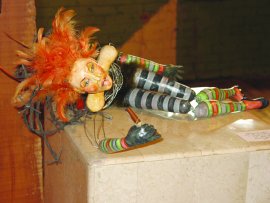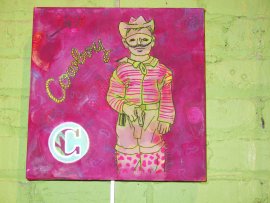 A small woman with clenched fists full of feathers plucked from her own legs is watched by smiling, colorful faces reminiscent of the simplistic advertising from the faux utopia of the 1950s. This is a microcosm of a room full of sculptures and paintings that present themselves with a straightforward charm that makes you smile, and then you realize there are darker themes that temper the smile with unease.
A small woman with clenched fists full of feathers plucked from her own legs is watched by smiling, colorful faces reminiscent of the simplistic advertising from the faux utopia of the 1950s. This is a microcosm of a room full of sculptures and paintings that present themselves with a straightforward charm that makes you smile, and then you realize there are darker themes that temper the smile with unease.
The current Duality of Whimsy show at the Bucktown Center for the Arts in downtown Davenport features the mixed-media narrative figures of Melanie De Keyrel Bell and the paintings of Heidi Hernandez. Both artists' oeuvres have an exhilarating tension between a saccharine, colorful veneer and some complex conceptual undertones. At times their works resonate like a collaboration between the cheerful Mr. Rogers and the more macabre Tim Burton.
Hernandez's bold paintings provide the first impressions of the show, but De Keyrel Bell's nearly 20 small figures - each of which suggests a compelling story - crown pedestals throughout the gallery and slowly assert themselves as a balancing force to the paintings on the wall.
Melanie De Keyrel Bell's mixed-media figures hit all of the right notes when it comes to found-object transformation. Her ability to foster tension between identities is important in works such as All of the Things I Could Not Say because an almost nonchalant treatment of materials cultivates a more interesting read for the viewer. Sprawled out on her side, over the top of a pedestal, is a female figure stretching out to deliver a bound scroll. Her hair, made from both orange-ish feathers and gray barbed wire, is a wild flurry of activity. This helps to bring attention to the head, which leads down to the pointed chin, where her open mouth seems to be struggling for its next utterance.
Her forearms and legs are round sausages of striped clay. The upper arms and torso are formed loosely from wire. Her torso is a bottle half-filled with numerous bound scrolls - undelivered missives, similar to the one clenched in her hand. These unspoken expressions are literally "bottled up inside."
Although the bottle and subsequently the scrolls are the conceptual focus of All of the Things I Could Not Say, De Keyrel Bell deals with all of the materials evenhandedly. Many artists would be tempted to over-emphasize what they feel is important. This eagerness to show their hand oftentimes prevents identity transformation by making the interactions between materials unbalanced. That often leads to a deflated viewing experience. Because no particular element is given excessive attention here, all of the physical ingredients are read as part of a uniform whole. De Keyrel Bell's maturity with media allows the bottle to assume dual identities.
While her figures are playful, there are often macabre undertones as well. Self-Portrait (Chicken Lady) shows a woman wearing an elaborate black-and-white dress sporadically stuffed with feathers. She has thick red legs, and the sheer size of her wild plume of black and blond hair is reminiscent of Tina Turner's explosive hairdo in Mad Max Beyond Thunderdome. Her eyes are protected by goggles as she leans to the right and gazes off into the distance. In her hands she clutches feathers.
The feathers suggests the violent act of plucking a chicken in preparation to cook and eat the bird, although it is unclear if she is preparing her body for self-consumption or the dining pleasure of others. The plucking of one's own feathers could also be interpreted as a woman's (or women's) self-mutilation efforts in the name of beautification.
Heidi Hernandez's works are brightly colored and celebrate the crisp faces and welcoming feel of 1950s magazine advertising. Sugar is one of several of her pieces that have an alphabet-book theme (in this case, the letter "S"), with the soft and safe look of children-friendly fare. A second glance reveals more complex themes that would not be found in the kids' section of the library.
 The primary tension in Sugar is between a girl on the left side, executed in cooler tones, who is lovingly shoveling a spoonful of sugar into her mouth, and a boy to the right, created with slightly warmer purplish pinks. The boy's eyes seem slightly glazed over, as if he were in a sugar-induced haze, and the word "Sugar" flows on a translucent green banner around the crown of his head.
The primary tension in Sugar is between a girl on the left side, executed in cooler tones, who is lovingly shoveling a spoonful of sugar into her mouth, and a boy to the right, created with slightly warmer purplish pinks. The boy's eyes seem slightly glazed over, as if he were in a sugar-induced haze, and the word "Sugar" flows on a translucent green banner around the crown of his head.
While Hernandez's work Sugar seems to celebrate the childhood joy of unfettered sugar consumption, she uses a subtle compositional device with several smaller circles that provide a more ominous counter-narrative. In one of the circles there is a cross-section of a tooth with a cavity caustically burrowing through the enamel and into the soft pulpy nerves. Two other circles diagram the locations of future dental drilling. The circles present the oversimplified parental dogma that vilifies sugar as the sole culprit in cavity formation.
C - Cowboy is another Hernandez work that plays Halcyon nostalgia against a more complex and possibly disturbing reality. The painting is executed primarily in reds, and the little cowboy just right of center is made of a combination of vermilion paint strokes and stitching. His gun and holster lie directly on top of his genitals. On the left side of the piece is the letter "C" in a sky-blue circle, and near the circle is the arching word "Cowboy" written in rope letters.
In lieu of using canvas for some of her works, Hernandez sometimes uses printed fabrics as a surface on which to paint. The foundation for C - Cowboy is a repetitive fabric print of several cowgirls. It is important to recognize that the paint literally covers/smothers the cowgirls on the surface, except for one only partially subdued cowgirl. There is a black arrow pointing away from her to what appears to be a microscopic view of an egg. Rhythmically along the painted surface are small squiggles that might represent sperm.
C - Cowboy can easily be a snapshot of the simple childhood fun of playing Cowboys & Indians. However, several factors indicate that this painting is far more than just visualized nostalgia. When you take into account the location of the boy's holster, the whole gun/penis metaphor becomes pretty blatant - succinct and unavoidable. There is considerable significance that the cowgirls on the fabric are all nearly subsumed in the painting process. Finally, the sperm and egg innuendos reinforce that the piece has undertones ranging from sexual conquest to gender domination.
Both De Keyrel Bell and Hernandez create works that are initially whimsical and enticing, but what truly makes the show memorable and such an appropriate pairing is how both of them cultivate such intriguing undercurrents within their pieces.










